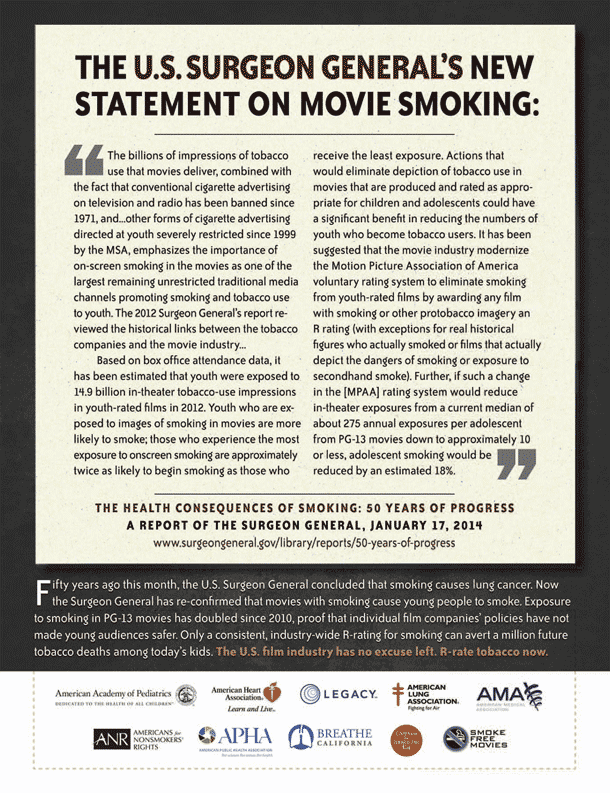February 5, 2014
In a move that shows real corporate social responsibility CVS/Caremark pharmacies has announced that is it going to stop selling cigarettes. This is an important substantive move that further removes exposure to tobacco and tobacco marketing from more people's lives and will make an important contribution to reaching former Surgeon General C. Everett Koop's vision of a smokefree society.
In press accounts CVS had said that they doubt that this move will actually reduce smoking. I think that is too pessimistic an assessment. Millions of people visit their pharmacies and removing tobacco imagery will almost certainly help prevent relapse of people who are trying to quit smoking. It is also one less place (actually over 7000 less places) that former smokers will be tempted to impulse by a pack of cigarettes.
January 28, 2014
Portrayals of tobacco use in U.S. films appear to have rebounded upward in the past 2 years (Chapter 14). In 2012, youth were exposed to an estimated 14.9 million in-theater tobacco use impressions in youth-rated films (Polansky et al. 2013). Youth who are exposed to images of smoking in movies are more likely to smoke; those who get the most exposure to onscreen smoking are about twice as likely to begin smoking as those who get the least exposure (USDHHS 2012). [Exec Summary page 15]
Actions that would eliminate the depiction of tobacco use in movies, which are produced and rated as appropriate for children and adolescents, could have a significant effect on preventing youth from becoming tobacco users. [Exec Summary, page 15]
After the broadcast advertising ban [in 1971], cigarette advertising and marketing continued to grow, but shifted to print publications, outdoor billboards, sponsorship of sports, placement of brand implants in movies, and a number of other methods. [page 26]
January 28, 2014
A bipartisan group of 45state attorneys general from both parties sent a strong letter to the US Trade Representative highlighting the threats of the TPP to state (and, by implication, local) tobacco regulation. This is an exceptionally strong statement and highlights the important role that the State AGs continue to play in tobacco control. The letter is here.
The letter includes many strong and specific legal arguments and is worth reading in full. One paragraph sums up the problem:
Experience has shown that state and local laws and regulations may be challenged by tobacco companies that aggressively assert claims under bilateral and multilateral trade and investment agreements, either directly under investor-state provisions or indirectly by instigating and supporting actions by countries that are parties to such agreements. Such agreements can enable these tobacco companies to challenge federal, state, and local laws and regulations under standards and in forums that would not be available under United States law.
January 27, 2014

The ad and supporting materials are at http://www.smokefreemovies.ucsf.edu/ourads/ad_sfm97.htm
January 26, 2014
Cati Brown, Lucy England, Pam Ling and I just published "Tobacco industry marketing to low socioeconomic status women in the USA" in Tobacco Control,
We used previously secret tobacco industry documents to shows that tobacco companies focused marketing on low SES women starting in the late 1970s, including military wives, low-income inner-city minority women, ‘discount-susceptible’ older female smokers and less-educated young white women. Strategies included distributing discount coupons with food stamps to reach the very poor, discount offers at point-of-sale and via direct mail to keep cigarette prices low, developing new brands for low SES females and promoting luxury images to low SES African-American women. More recently, companies integrated promotional strategies targeting low-income women into marketing plans for established brands.
